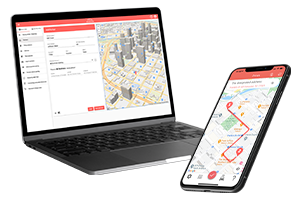March 6, 2024
Navigating the financial landscape of vehicle ownership and operation in today’s economy requires a keen understanding of various cost metrics, including the cost to drive per mile, wear and tear costs, and organizational costs amortization, among others. Whether you’re a business owner scrutinizing the cost of driving per mile for a fleet of vehicles or an individual trying to budget for personal travel expenses, understanding these costs is pivotal.
The IRS provides guidelines for the cost per mile to drive, known as the IRS cost per mile, which serves as a cornerstone for calculating deductible expenses related to business use of a personal vehicle. This rate reflects not just the fuel cost, but also the average wear and tear cost per mile and the depreciation of the vehicle over time.

Moreover, for businesses, the amortization of organizational costs presents an additional layer of financial planning. These costs, which include the expenses incurred during the formation of a company, such as legal fees and state incorporation fees, can be gradually deducted over a period, impacting the overall financial health of the organization. Understanding how to navigate these costs, alongside the federal cost per mile and the current cost per mile, is crucial for accurate budgeting and financial forecasting.
Whether it’s managing the direct expenses of vehicle operation or strategizing the deduction of organizational costs, a comprehensive grasp of these figures will empower drivers and business owners alike to make informed decisions, ultimately optimizing their financial resources in the dynamic landscape of 2024.
The Link Between Mileage Cost and Tax Deductions: Maximizing Your Savings
Understanding the intricate connection between mileage cost and tax deductions is crucial for anyone looking to maximize their financial savings, whether you’re a sole proprietor or managing a fleet of vehicles for your business. The IRS cost per mile offers a standard deduction rate for business-related travel, reflecting not just the fuel expenditure but also the average cost of wear and tear per mile. This deduction is pivotal for accurately reporting organizational costs and ensuring that every mile driven for business purposes contributes to lower taxable income.
Key Insights:
- Utilizing the IRS cost per mile guideline helps streamline the deduction process, offering a straightforward method to account for vehicle cost per mile.
- Properly documented mileage costs can significantly reduce your taxable income by including not only the direct expenses of operating a vehicle but also the amortization of organizational costs related to vehicle use.
- Understanding the current cost per mile and how it impacts your tax obligations can lead to more effective budgeting and financial planning, ensuring that businesses and individuals alike are leveraging tax laws to their fullest advantage.
By aligning your mileage tracking practices with tax deduction strategies, you can transform the cost to drive per mile into a powerful tool for financial optimization.
Frequently Asked Questions
Q: How do I calculate my vehicle’s cost per mile for tax purposes?
A: You can use the IRS’s standard mileage rate, which factors in the cost to drive per mile including fuel, maintenance, and wear and tear. Simply multiply the total business miles driven by the IRS cost per mile rate for the year. Alternatively, you can calculate your actual expenses by tracking all vehicle-related costs and amortizing organizational costs related to the vehicle.
Q: What documentation do I need to claim mileage on my taxes?
A: To claim mileage deductions, you need a detailed log of your business trips that includes dates, destinations, purposes of the trips, and the number of miles driven. Receipts for vehicle costs and records of organizational costs should also be kept to substantiate your claims, especially if you’re using actual expenses instead of the standard rate.
Q: Can I claim both the standard IRS mileage rate and actual vehicle expenses on my taxes?
A: No, you must choose between using the standard IRS cost per mile rate or calculating your actual vehicle costs per mile including amortization of organizational costs. Once you opt for the standard mileage rate in the first year the vehicle is used for business, you cannot switch to actual expenses for that vehicle in any later year. Conversely, if you start with actual expenses, you may have the option to choose later on, depending on your vehicle and business use.
Q: Does commuting to work count as a deductible business mileage?
A: Generally, commuting expenses between your home and regular workplace are not deductible. However, trips from your office to a secondary business location or to meet clients can count as business mileage, reducing your overall cost to drive per mile through tax deductions.
Q: Are there any limitations or caps on how much mileage I can deduct?
A: While there’s no strict limit on the number of miles you can deduct, the IRS cost per mile deduction is subject to scrutiny. All claimed mileage must be business-related, and excessive deductions compared to your income level may raise flags. Ensure your documentation is thorough and reflects a legitimate business necessity to avoid issues with tax authorities.
Maintenance and Its Role in Fuel Economy
In the grand journey of 2024, where fuel prices and environmental concerns are more pressing than ever, vehicle maintenance has emerged as a hero in the quest for fuel efficiency.
It’s not just about keeping your car running smoothly; it’s about making every drop of fuel count. Let’s delve into how regular maintenance can play a pivotal role in enhancing your vehicle’s fuel economy, ensuring that your ride remains as efficient as possible.
The Golden Trio: Tires, Oil, and Air Filters
Believe it or not, some of the most straightforward maintenance tasks can have the most significant impact on your vehicle’s fuel efficiency.
Tire Pressure: Underinflated tires can reduce fuel economy by up to 3% per tire. Keeping them inflated to the manufacturer’s recommended level not only saves fuel but also extends the life of your tires.
Engine Oil: Using the manufacturer-recommended grade of motor oil can improve your fuel economy by 1-2%. Modern engines are designed to operate efficiently with specific oil viscosities.
Air Filters: A clean air filter allows your engine to breathe easier, improving performance and fuel economy. A dirty filter can significantly decrease air flow to the engine, reducing efficiency.
Regular Check-Ups: The Secret to Longevity
Just like humans, vehicles benefit greatly from regular check-ups. These not only keep your car running efficiently but also catch potential issues before they become major problems.
Key Maintenance Checks:
- Spark Plugs: Faulty spark plugs can reduce fuel efficiency by up to 30%. Regular checks ensure your engine is firing on all cylinders.
- Fuel System: Keeping your fuel system—including the fuel injectors—clean ensures optimal performance and efficiency.
- Battery: A struggling battery can force your vehicle to work harder, impacting fuel efficiency. Ensure it’s checked and replaced as necessary.
FAQs: Keeping Your Ride Fuel-Efficient
Q: How often should I perform these maintenance tasks? A: Your vehicle’s owner manual is the holy grail for maintenance schedules. Generally, tire pressure should be checked monthly, oil changes typically occur every 5,000 to 7,500 miles, and air filters should be checked at least every 15,000 miles. However, these intervals can vary based on your vehicle and driving conditions.
Q: Can regular maintenance improve my car’s resale value? A: Absolutely! A well-maintained vehicle not only runs more efficiently but also has a higher resale value. Regular maintenance records can be a significant selling point for potential buyers.
Q: Is it worth using premium fuels for better fuel economy? A: This depends on your vehicle. Some high-performance vehicles recommend or require premium fuel for optimal performance and efficiency. However, for most vehicles, using regular unleaded gasoline is perfectly fine and won’t negatively impact fuel economy. Always refer to your vehicle’s manual for guidance.
Fuel Prices: Trends and Predictions for 2024
In the roller-coaster world of fuel prices, 2024 has already thrown us a few loops and turns. Understanding these trends and what they mean for your wallet can be as crucial as knowing how to squeeze every mile out of a gallon of gas. So, buckle up as we navigate through the current landscape of fuel prices, uncovering what drives changes and how you can stay ahead of the curve.
The Driving Forces Behind Fuel Prices
Several key factors influence the cost of fuel, from geopolitical tensions to environmental policies, and even technological advancements. Here’s a quick breakdown:
- Global Oil Supply and Demand: The classic economic principle of supply and demand significantly affects fuel prices. Any disruption in oil-producing regions can lead to price spikes.
- Geopolitical Events: Political instability in oil-rich regions often results in fluctuating fuel prices due to potential supply disruptions.
- Environmental Policies: Initiatives aimed at reducing carbon emissions can affect fuel prices. For example, taxes on carbon emissions can lead to higher fuel prices as a way to encourage reduced fossil fuel consumption.
- Technological Advances: Innovations in energy extraction and fuel efficiency can impact oil demand and, subsequently, prices.
Predictions for 2024 and Beyond
Forecasting fuel prices is notoriously challenging, but current trends suggest a few possible directions for 2024:
- Gradual Increase in Prices: With the global economy recovering, demand for fuel is expected to rise, potentially pushing prices up.
- Renewable Energy Impact: As renewable energy sources become more prevalent and cost-effective, the demand for fossil fuels may decrease, potentially stabilizing or even lowering fuel prices in the long term.
FAQs: Navigating Fuel Price Trends
Q: How can I keep track of fuel prices? A: Numerous apps and websites provide real-time fuel price information, helping you find the best prices in your area. Staying informed can help you fill up smarter and even time your purchases to when prices are typically lower.
Q: What’s the best way to budget for fluctuating fuel prices? A: One approach is to calculate your monthly fuel costs based on the higher end of the price spectrum. This way, if prices drop, you’ll have extra savings, and if they rise, you’re already prepared.
Q: Can fuel-efficient driving really offset rising fuel prices? A: Absolutely! Adopting fuel-efficient driving habits and maintaining your vehicle can significantly reduce your fuel consumption, helping to mitigate the impact of rising fuel prices.
Leveraging MileageWise for Tax Deductions: A Smart Strategy to Reduce Mileage Costs

In 2024, savvy drivers and business owners are always on the lookout for intelligent ways to reduce their mileage costs. One such method that has garnered attention is the strategic use of MileageWise, a comprehensive tool designed to optimize and legitimize your mileage logs for tax deduction purposes. Understanding how to effectively use MileageWise can turn your everyday driving into significant savings come tax season. Let’s explore how this tool can be a game-changer in managing your mileage costs.
Streamlining Mileage Tracking
MileageWise stands out for its ability to simplify the once-tedious task of tracking every mile driven for business purposes. With its user-friendly interface and intelligent features, users can ensure that no trip goes unlogged and no deduction is missed.
Key Features of MileageWise:
- Automatic Trip Logging: Utilizes your smartphone’s GPS to automatically record trips, ensuring accuracy and completeness.
- Past Mileage Recovery: Forgot to log a trip? MileageWise’s unique feature allows users to reconstruct past journeys accurately, maximizing your deductions.
- IRS-Proof Reports: Generates detailed mileage logs that comply with IRS requirements, minimizing the risk of audits.
Maximizing Your Deductions
By accurately tracking your business mileage, MileageWise not only helps in reducing your taxable income but also in increasing your tax return. The IRS offers a standard mileage rate deduction for every business mile driven, and with MileageWise, you can effortlessly capture every eligible mile.
How MileageWise Enhances Deductions:
- Detailed Documentation: Provides the detailed documentation required by the IRS, including dates, miles, and purposes of trips.
- Maximize Every Mile: Ensures you’re claiming the maximum deduction possible by meticulously recording all business-related mileage.
- Educational Resources: Offers insights and tips on maximizing deductions and staying compliant with tax laws.
FAQs: Making the Most of MileageWise for Tax Deductions
Q: How does MileageWise ensure my mileage logs are IRS-compliant? A: MileageWise adheres to IRS requirements by capturing all necessary data points for each trip, including the date, purpose, and start/end locations. Its reports are designed to meet IRS standards, providing peace of mind and audit-proof documentation.
Q: Can MileageWise track mileage for multiple vehicles and drivers? A: Yes, MileageWise can accommodate businesses of all sizes, from single users with one vehicle to companies with multiple vehicles and drivers. It’s an ideal solution for ensuring comprehensive mileage documentation across a diverse fleet.
Q: What if I forget to log a trip? A: MileageWise’s past mileage recovery feature allows you to fill in missing trips using historical Google Maps data, ensuring that you can claim the maximum possible deduction without missing a beat.
Wrapping Up
In wrapping up our exploration of mileage costs, it’s evident that strategic management of these expenses is key to enhancing financial well-being. By understanding the nuances of the cost to drive per mile and leveraging tax deductions, individuals and businesses alike can significantly reduce their transportation expenditures.
Emphasizing the importance of maintenance, efficient driving habits, and meticulous documentation, particularly regarding the IRS cost per mile and amortization of organizational costs, not only aids in minimizing costs but also in maximizing potential tax benefits.
The journey towards financial efficiency in transportation is ongoing, blending diligence with smart decision-making. By applying the insights from this article, you’re equipped to navigate mileage costs more effectively, ensuring every mile and dollar spent contributes positively to your financial landscape. Let this be your guide to smarter travel and better financial health in the future.
Download MileageWise’s automatic mileage tracker app from Google Play or the App Store & try it for free for 14 days. No credit card required!



